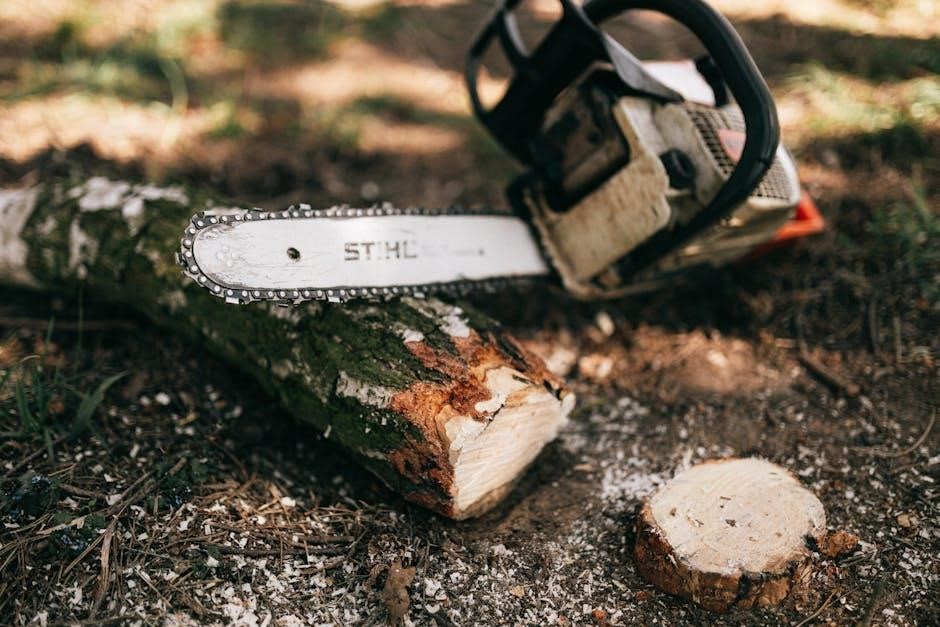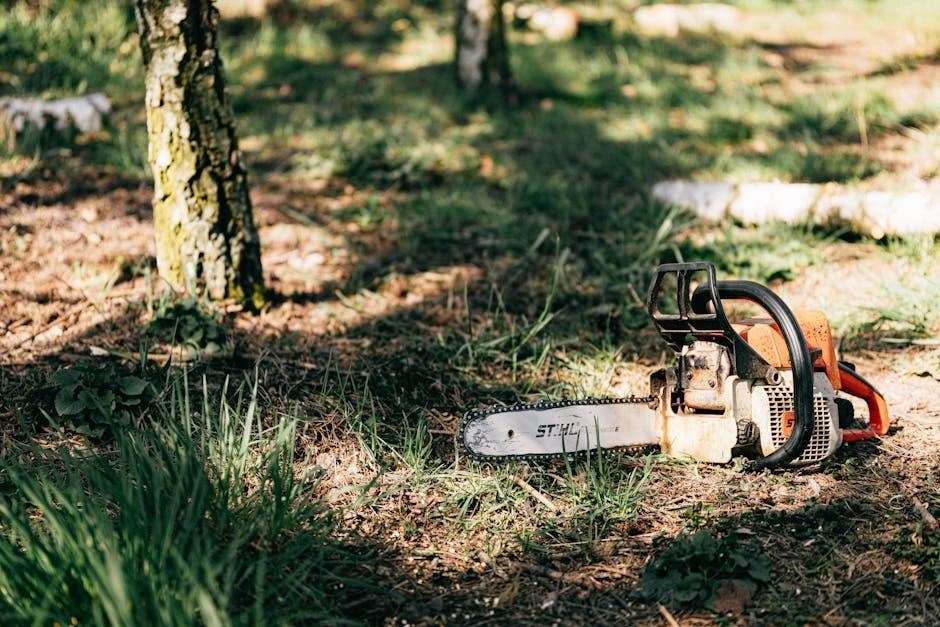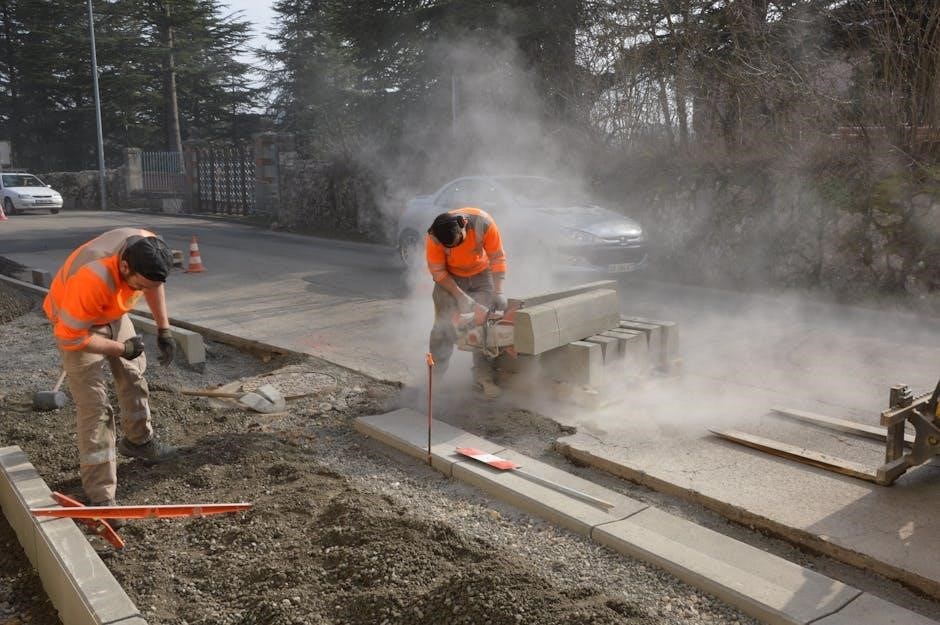chainsaw guides
Summary
Conquer any woodcutting task! Our chainsaw guide helps you pick the perfect saw & master safe, effective techniques. Become a chainsaw pro today!

Understanding Chainsaw Guide Bars
The chainsaw guide bar is the backbone of the tool, holding the cutting chain and dictating cutting capacity․ Selecting the right guide bar is critical for performance, safety, and efficiency․ Different types cater to varied cutting needs, and understanding the available options is crucial for informed decision-making․
Anatomy of a Chainsaw Guide Bar
Anatomy of a Chainsaw Guide Bar
A typical chainsaw guide bar consists of several key parts, each playing a crucial role in its function․ The bar body, usually made of steel, forms the main structure and provides the track for the cutting chain․ The groove or rail is the guide slot within the bar body where the cutting chain glides, facilitating smooth cutting motions․ The nose, the tip of the bar, impacts cutting precision, especially in tight spaces, and some bars feature a nose sprocket to reduce friction․ The mounting holes are points for securing the bar to the chainsaw body․ Understanding these components is essential for proper maintenance and replacement․
The guide bar also includes a guide slot, where the bar is attached to the saw body, usually with screws that run through the slot and onto the clutch cover․ Other notable components include the bar’s oil holes, which supply lubrication to the chain as it travels around the bar, and the tensioning pin hole, used to adjust the chain’s tension․ High-quality guide bars are designed with features that enhance durability and performance, such as hardened rails to resist wear and precision engineering for optimal chain alignment․ Recognizing these anatomical features enables users to better understand how the guide bar interacts with other chainsaw components, ensuring safe and effective operation․
Types of Chainsaw Guide Bars
Types of Chainsaw Guide Bars
Understanding the diverse range of chainsaw guide bars is crucial for making informed decisions that align with specific cutting needs․ Several types of guide bars are available, each designed with unique features and construction methods to optimize performance in different applications․ Laminated bars are comprised of multiple layers, helping reduce the front-end weight of the chainsaw, making them suitable for general use and smaller saws․ Solid guide bars, often with a Stellite tip, are professional-grade bars made from a single piece of steel, offering increased durability and resistance to wear, particularly in demanding cutting conditions․ Some solid bars feature a replaceable nose sprocket, further extending their lifespan and reducing friction․ Carving bars are specifically designed for intricate carving work, providing enhanced precision and control․
Other variations include bars with different nose designs, such as those with a sprocket nose, which reduces friction and wear on the chain․ The construction of the bar also impacts its performance; for example, some bars are designed to be more rigid, providing better control during heavy-duty cutting, while others are more flexible, allowing for easier maneuverability in tight spaces․ Additionally, guide bars vary in length, affecting the chainsaw’s cutting capacity․ Selecting the appropriate type of guide bar depends on factors such as the chainsaw’s power, the type of cutting being performed, and the user’s skill level․ Proper matching of the guide bar to the chainsaw ensures safe and efficient operation, maximizing the tool’s potential while minimizing the risk of damage or injury․

Guide Bar Selection Criteria

Guide Bar Selection Criteria
Selecting the right guide bar is critical for chainsaw performance, safety, and efficiency․ Factors to consider include matching bar length to chainsaw power, identifying existing equipment (bar, chain, sprocket), and understanding fundamental measurements to ensure compatibility and optimal operation․
Matching Bar Length to Chainsaw Power
Matching Bar Length to Chainsaw Power
A general understanding is that a more powerful chainsaw can handle a bigger bar, while a less powerful chainsaw requires a smaller bar․ Matching the bar length to the chainsaw’s power is crucial for optimal performance and safety․ An oversized bar on a small chainsaw can strain the motor, reduce cutting speed, and increase the risk of kickback․ Conversely, a bar that is too short on a powerful chainsaw might not fully utilize the saw’s capabilities․ Consider the engine’s cubic capacity (cc) or horsepower (HP) when determining the appropriate bar length․ Consult the chainsaw manufacturer’s recommendations for the suitable bar length range for your specific model․ These recommendations are typically found in the owner’s manual or on the manufacturer’s website․ For example, a chainsaw with a 40cc engine might be best suited for a 16-inch bar, while a 60cc engine could handle an 18-inch or 20-inch bar․ When in doubt, it’s generally safer to err on the side of a shorter bar, as it will be easier to control and less likely to overload the engine․ Experienced users might choose a longer bar for specific tasks, but they should have the necessary skills and experience to handle the increased power and potential for kickback․ Ultimately, selecting the correct bar length for your chainsaw’s power will ensure efficient cutting, prolong the life of the saw, and enhance user safety․ Always prioritize safety and consult with professionals if you are unsure about the appropriate bar length for your chainsaw․ Remember to check the specific guide bar package for any included warning information․
Identifying Existing Equipment (Bar, Chain, Sprocket)
Identifying Existing Equipment (Bar, Chain, Sprocket)
Before replacing or upgrading any chainsaw parts, it’s essential to accurately identify your existing equipment, including the bar, chain, and sprocket․ This ensures compatibility and prevents potential safety hazards․ Start by examining the guide bar itself․ Most guide bars have stamped markings that indicate the bar length, chain pitch, gauge, and the number of drive links required for the chain․ These markings are usually located near the mounting end of the bar․ If the markings are worn or illegible, you can measure the bar length from the mounting point to the tip․ To determine the chain pitch, measure the distance between any three consecutive rivets on the chain and divide by two․ The gauge is the thickness of the drive links that fit into the bar groove․ It can be measured with a caliper or by checking the bar for a stamped gauge number․ The number of drive links can be determined by manually counting them on your existing chain․ Next, inspect the sprocket․ The sprocket is the toothed wheel that drives the chain around the bar․ The number of teeth and the pitch of the sprocket must match the chain pitch for proper operation․ If the sprocket is worn, it should be replaced along with the chain and bar to ensure optimal performance and prevent premature wear․ If you are unsure about any of these measurements or markings, consult your chainsaw’s owner’s manual or contact a qualified chainsaw technician․ They can help you accurately identify your existing equipment and recommend the appropriate replacement parts․ Always prioritize safety and ensure that all components are compatible before operating your chainsaw․ Remember to consult with professionals if you are unsure about the identification of any of the existing components in your chainsaw system․

Key Measurements for Chainsaw Parts
Key Measurements for Chainsaw Parts
Understanding the key measurements of chainsaw parts is crucial for proper chain and bar selection․ These measurements, including pitch, gauge, and the number of drive links, ensure compatibility and optimal performance․ Accurate measurements are vital for safe and efficient chainsaw operation․
Pitch, Gauge, and Drive Links
When selecting a chainsaw chain, understanding pitch, gauge, and drive links is essential for ensuring compatibility and optimal performance․ These three measurements are fundamental to matching the correct chain to your chainsaw’s bar and sprocket․
Pitch: Pitch refers to the size of the chain and is defined as the distance between any three consecutive rivets divided by two․ It’s typically measured in inches․ Common chainsaw pitches include 3/8″ (0․375″), ․325″, and ․404″․ The pitch must match the sprocket and guide bar for proper engagement and cutting efficiency․ Using the wrong pitch can lead to chain slippage, damage to the chainsaw, and potentially dangerous situations․ Always consult your chainsaw’s manual or the guide bar for the correct pitch specification․
Gauge: Gauge is the thickness of the drive links, which are the parts of the chain that fit into the groove of the guide bar․ It’s measured in thousandths of an inch (e․g․, ․050″, ․058″, ․063″)․ Like pitch, the gauge of the chain must match the gauge of the guide bar․ If the gauge is too small, the chain will fit loosely and may derail․ If the gauge is too large, the chain won’t fit into the guide bar groove at all․ Matching the correct gauge ensures smooth chain movement and prevents premature wear of both the chain and the guide bar․
Drive Links: Drive links are the small, tooth-like parts of the chain that engage with the sprocket and fit into the guide bar groove․ The number of drive links determines the length of the chain and is crucial for ensuring a proper fit on the chainsaw․ To determine the correct number of drive links, consult your chainsaw’s manual or the specifications on the guide bar․ You can also count the number of drive links on your existing chain․ Using a chain with the wrong number of drive links will result in either a chain that is too loose or too tight, both of which can cause damage and safety hazards․

Guide Bar Maintenance
Proper maintenance of your chainsaw guide bar is crucial for ensuring its longevity, optimal performance, and safe operation․ A well-maintained guide bar contributes to smoother cuts, reduces the risk of chain derailment, and extends the overall lifespan of your chainsaw․ Regular inspection and maintenance should be a routine part of your chainsaw usage․
Regular Cleaning: After each use, clean the guide bar thoroughly to remove sawdust, debris, and accumulated pitch․ Use a stiff brush or a scraper to clear the groove along the bar’s edge where the chain rides․ Clogged grooves can cause friction, overheating, and uneven chain wear․ Ensure the oil hole is clear to allow for proper lubrication․ Compressed air can also be used to blow out debris from hard-to-reach areas․
Checking for Wear and Damage: Regularly inspect the guide bar for signs of wear, such as burrs, uneven rails, or damage to the bar’s surface․ Burrs can be filed down with a flat file to prevent them from damaging the chain․ Uneven rail wear can be corrected by using a bar rail dressing tool, which ensures the rails are level and the chain runs smoothly․ If the bar is bent, cracked, or severely damaged, it should be replaced immediately․
Filing the Rails: As the guide bar is used, the rails can become uneven, leading to chain wobble and poor cutting performance․ Use a bar rail dressing tool to file the rails and ensure they are square and level․ This process helps maintain the correct chain depth and improves cutting efficiency․ Follow the manufacturer’s instructions for using the dressing tool to avoid damaging the bar․
Lubrication: Proper lubrication is essential for reducing friction and wear on the guide bar and chain․ Always use a high-quality bar and chain oil and ensure the oiler is functioning correctly․ Check the oil level frequently and refill as needed․ Insufficient lubrication can lead to overheating, premature wear, and even seizure of the chain․ The oiler hole must be kept clear from debris․
Bar Rotation: Periodically rotate the guide bar to promote even wear on both sides․ This simple practice can significantly extend the life of the bar by distributing the wear more evenly․ When reinstalling the bar, make sure it is properly seated and the chain tension is correctly adjusted․
By following these maintenance tips, you can keep your chainsaw guide bar in excellent condition, ensuring safe and efficient cutting performance for years to come․ Neglecting these practices can lead to costly repairs or the need for premature replacement of the guide bar․